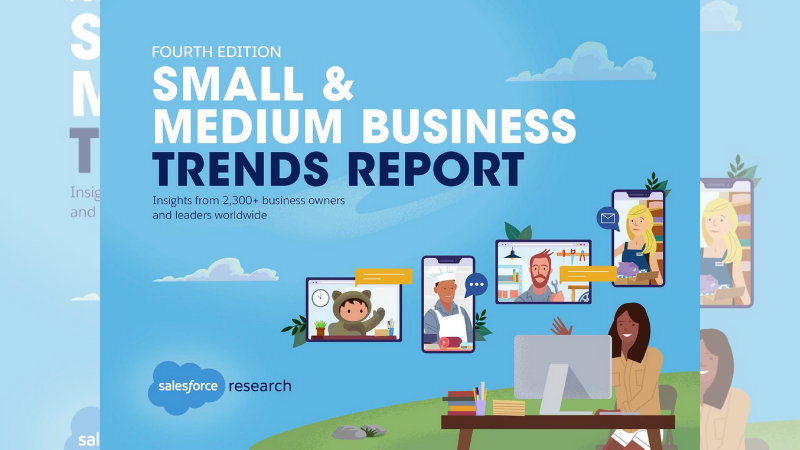Economy
Insights from Dual Surveys Reveal the Striking Impact of Crises on Small Businesses

Salesforce published the fourth edition of its Small & Medium Business Trends Report. This research was conducted in two parts, with a study in March 2020 and a follow-up study in August 2020, providing insights from SMB owners and leaders at the beginning and in the midst of the pandemic.
This year has presented challenges for businesses of all sizes, and small and medium businesses (SMB) have experienced more than their share. This research gives us the most up-to-date look at how, six months in, SMB owners and leaders are weathering overlapping health, economic, and racial injustices crises, and adapting to the current climate.
The research included more than 2,300 SMB owners and leaders in North America, South America, Europe, and Asia Pacific. Small and medium-sized businesses are defined as 2-200 employees and an annual revenue of less than $1 billion.
“Small businesses have always been a critical part of our economy, and it’s especially important that we support them during this pandemic,” said Meredith Schmidt, GM and EVP, Essentials and SMB, Salesforce. “We hope these insights give SMB leaders around the world inspiration on how other businesses are navigating this challenging period and achieving resilience. I am optimistic that SMBs will and can move forward with grit and creativity.”
Some key insights from the Small & Medium Business Trends Report include:
Customer focus remains a key trait of growing SMBs
Growing SMBs, defined as having 1% or more revenue increase over the last six months, are most likely to have taken actions to improve customer interactions since the pandemic took hold. They also seem better poised to offer customers flexibility, such as, easier return policies and payment plans. In addition, growing SMBs are more likely to prioritize developing stronger customer relationships over one-time transactions.
SMB optimism persists amid new challenges
Many SMBs were hit particularly hard by the pandemic due to their already-short runway on resources. The top three constraints on current business operations continue to be money/access to capital, meeting customer expectations, and hiring the right talent — all of which are the same as early on in the pandemic, in March.
However, COVID-19 has added compounding challenges as well — reduced revenue, reduced customer demand, and public health mandates are ranked the top three pandemic-related challenges constraining businesses. Not surprisingly, 3 in 5 SMB leaders say local mandates to close or limit operations are threatening the viability of their business or that compliance with public health requirements creates an excessive burden.
Even with these challenges, 22% of SMBs say they are very optimistic and 50% of SMBs say they are somewhat optimistic about the future of their business.
Digital-forward SMBs are more equipped to handle market volatility
SMBs’ use of technology has continued to increase over the years, with more than half now saying they use a customer relationship management system, a 24% increase from 2019. Even during the pandemic, SMBs are continuing to adopt new technology, with at least 1 in 5 SMB leaders reporting they’ve implemented at least one of the following technology solutions in the last six months, including email marketing software, customer service software, project task collaboration tools, or e-commerce software.
Around another 1 in 5 SMB leaders don’t currently use these solutions but have plans to in the next 12 months. In addition, SMB leaders have been steadily using fewer applications over the past year and nearly three quarters (72%)* believe that one centralized application to manage their business functions would be helpful.
Country Trends
Despite the significant impact of the pandemic on businesses across the world, SMB owners remain seemingly optimistic across the board, with all countries sharing expectations of business as usual following the pandemic, or only slight modifications.
The majority of SMB leaders in the US (43%), Germany (46%), Thailand (44%) and Australia/New Zealand (51%) expect business as normal, while slightly modified business was the most commonly expected outcome in Brazil (47%), Canada (51%), UK/Ireland (45%), as well as Spain and Italy (59%) among others.
bHowever, when SMB leaders are thinking about the future of their business, applying for financial assistance and decreasing staff were cited as two of the top three considerations by every country.
For a deeper analysis of findings, visit our blog and download the full Small & Medium Business Trends Report.
*Responses from the March 2020 survey.
-

 Real Estate2 months ago
Real Estate2 months agoAl Mouj Muscat Unveils Azura Beach Residences Phase 2: A New Chapter in Waterfront Living
-

 Leaders Speak1 month ago
Leaders Speak1 month agoDhofar International Development and Investment Company: Driving Sustainable Growth and Strategic Synergies in Oman’s Investment Landscape
-

 Events1 month ago
Events1 month agoOER Corporate Excellence Awards 2025 Honours Entities and Innovations in Oman
-

 Economy1 month ago
Economy1 month agoMaal Card: What Oman’s New National Payment Card Means for Everyday Users
-

 OER Magazines2 months ago
OER Magazines2 months agoOER, October 25
-

 Arts and Culture2 months ago
Arts and Culture2 months agoOminvest and Bait Al Zubair Launch “Future Frames” to Empower Youth through Art and AI
-

 Entertainment2 months ago
Entertainment2 months agoWhere Heritage Meets Haute Couture: Al Sadaa Haute Couture Transforms the Sultanate’s Fashion Scene
-

 News2 months ago
News2 months agoMs. Noor Saldin, Founder of Modern Generation International School, Wins Woman of the Year 2025; School Honored for Empowering Future Female Leaders






























